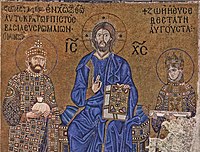Byzantine Greeks
 Medieval Greek marriage and family life. | |
| Regions with significant populations | |
|---|---|
| Byzantine Empire(especiallyAsia Minor,Balkans) | |
| Languages | |
| Medieval Greek | |
| Religion | |
| OrthodoxChristianity |
TheByzantine Greeks(orByzantines) were theGreek peopleof Late Antiquity and theMiddle Ages.[1]They lived in the lands of theByzantine Empire,then called the Eastern Roman Empire, likeGreece,Asia MinorandCyprus.They spokemedieval Greek,preserved Greek culture, obeyedRoman lawand followedEastern Christianity.Their society had peasants, traders, teachers, soldiers and priests.
Identity
[change|change source]The Byzantines called themselvesRomans(Romaioi),Greeks(Graikoi,Hellenes) andChristians(Christianoi) throughout their history.[2]They used those names synonymously because they were the political heirs of theRoman Empire,the offspring of the ancient Greeks, and believers inJesus Christ.[3]The Byzantines also called everything that was not Greek "barbarian" and calledpaganism"Hellenism".[4]
Society
[change|change source]

Byzantine Greek society had different classes like the poor, the peasants, the soldiers, the teachers, the merchants, and the priests.[5]
Poor and peasants
[change|change source]There were two groups of poor people in the Greek world since the time ofHomer:theptochos(πτωχός,"passive poor" ) and thepenes(πένης,"active poor" ).[6]Byzantine Greek peasants lived in villages; drankwine;and ategrains,beans,fish,breadandolives.[7]They were hunters, fishers, bee-keepers, craftsmen, smiths, tailors and shoemakers.[8]
Soldiers and teachers
[change|change source]Soldiers were chosen for military duty every year and served as medics and technicians.[9]Their appearance, customs, habits and life were part of Greek and Roman military tradition.[10]Along with farmers, they ate a type of dried biscuit or hard bread, called apaximadion(originally called aboukelaton).[11]
Byzantine education was part of an ancient Greek educational tradition that started in the 5th century BC.[12]It was made up of three levels: elementary school with students aged six to ten years old, secondary school with students aged ten to sixteen years old and higher education.[13]
Literacy was much higher in the Byzantine Empire than inWestern Europe.[13][14]Elementary school education was widely available in places like towns and the countryside.[13]Secondary schools were mostly in larger cities, andhigher educationwas offered at the University ofConstantinople.[13]
In elementary schools, teachers used simple fairy-tale books likeAesop's Fables.[15]In secondary schools, teachers used ancient Greek texts like theIliadand theOdysseyofHomer.[15]
Women
[change|change source]The life of a Byzantine Greek woman was split into three stages: girlhood, motherhood and widowhood.[16]Daily life for women included doing household and farm chores.[17]Poor women sometimes wore sleeveless tunics, and most wore aveil,called themaphorion,which covered their hair.[18]Wealthy women bought and wore silk fabrics and clothes with expensivejewelry.[18]Some women worked as traders, clerics and teachers.[19]
Traders and priests
[change|change source]Byzantine Greek traders were mobile and developed new methods of investing money like thechreokoinonia.[20]Byzantine Greek priests were close to the rest of society and were allowed to get married except for bishops.[21]
Related pages
[change|change source]References
[change|change source]Citations
[change|change source]- ↑Ahrweiler 1976,pp. 19–60, 78;Clover & Humphreys 1989,p. 10ff;Linnér 1994,p. 219ff;Lemerle 1971,pp. 52–71, 279–285;Baynes & Moss 1948,p. 23ff.
- ↑Papadopoulou 2014,pp. 157–176;Niehoff 2012,Margalit Finkelberg, "Canonising and Decanonising Homer: Reception of the Homeric Poems in Antiquity and Modernity", p. 20;Harrison 2002,p. 268;Vryonis 1999,pp. 19–36;Runciman 1970,p. 14.
- ↑Kazhdan & Constable 1982,p. 12;Runciman 1970,p. 14;Kitzinger 1967,"Introduction", p. x;Runciman 1970,p. 14;Haldon 1999,p. 7;Browning 1992,"Introduction", p. xiii.
- ↑Ciggaar 1996,p. 14;Vryonis 1999,p. 27.
- ↑Cavallo 1997,p. 2.
- ↑Cavallo 1997,pp. 15, 17.
- ↑Cavallo 1997,pp. 44, 49.
- ↑Cavallo 1997,pp. 55–56.
- ↑Cavallo 1997,pp. 76–77.
- ↑Cavallo 1997,p. 75.
- ↑Dalby 1996,p. 196;Kochilas 1993,p. 50.
- ↑Cavallo 1997,p. 95.
- ↑13.013.113.213.3"Education: The Byzantine Empire".Encyclopædia Britannica.Encyclopædia Britannica, Inc. 2016.Retrieved16 May2016.
- ↑Rautman 2006,p. 282: "Unlike the early medieval West, where education took place mainly in monasteries, rudimentary literacy was widespread in Byzantine society as a whole."
- ↑15.015.1Cavallo 1997,p. 96.
- ↑Cavallo 1997,p. 119.
- ↑Cavallo 1997,pp. 119–120.
- ↑18.018.1Cavallo 1997,p. 127.
- ↑Rautman 2006,p. 26.
- ↑Laiou & Morrison 2007,pp. 139–140.
- ↑Rautman 2006,p. 23.
Sources
[change|change source]- Ahrweiler, Helene (1975).L'Ideologie Politique de l'Empire Byzantine [The Political Ideology of the Byzantine Empire](in French). Paris: Presses Universitaires de France.
- Baynes, Norman Hepburn; Moss, Henry St. Lawrence Beaufort (1948).Byzantium: An Introduction to East Roman Civilization.Oxford: Clarendon Press.
- Browning, Robert (1992).The Byzantine Empire.Washington, DC: Catholic University of America Press.ISBN0-8132-0754-1.
- Cavallo, Guglielmo (1997).The Byzantines.Chicago, IL: University of Chicago Press.ISBN0-226-09792-7.
- Ciggaar, Krijnie (1996).Western Travellers to Constantinople: The West and Byzantium, 962–1204: Cultural and Political Relations.Leiden: E. J. Brill.ISBN978-90-04-10637-6.
- Clover, F. M.; Humphreys, R. S. (1989).Tradition and Innovation in Late Antiquity.Madison, WI: University of Wisconsin Press.ISBN9780299120009.
- Dalby, Andrew (1996).Siren Feasts: A History of Food and Gastronomy in Greece.London and New York: Routledge.ISBN978-1-13-496985-2.
- Haldon, John F. (1999).Warfare, State and Society in the Byzantine World, 565–1204.London: University College London Press (Taylor & Francis Group).ISBN1-85728-495-X.
- Harrison, Thomas (2002).Greeks and Barbarians.New York, NY: Routledge.ISBN0-415-93958-5.
- Kazhdan, Alexander Petrovich; Constable, Giles (1982).People and Power in Byzantium: An Introduction to Modern Byzantine Studies.Washington, DC: Dumbarton Oaks.ISBN0-88402-103-3.
- Kitzinger, Ernst (1967).Handbook of the Byzantine Collection.Washington, DC: Dumbarton Oaks.ISBN0-88402-025-8.
- Kochilas, Diane (1993) [1990].The Food and Wine of Greece: More Than 250 Classic and Modern Dishes from the Mainland and Islands.New York, NY: St. Martin's Press.ISBN978-0-312-08783-8.
- Laiou, Angeliki E.; Morrison, Cécile (2007).The Byzantine Economy.Cambridge: Cambridge University Press.ISBN978-0-521-84978-4.
- Lemerle, Paul (1971).Le Premier Humanisme Byzantin [The First Byzantine Humanism](in French). Paris: Presses Universitaires de France.
- Linnér, Sture (1994).Bysantinsk kulturhistoria [History of Byzantine Culture](in Swedish). Stockholm: Norstedt.ISBN978-9-11-941512-7.
- Niehoff, Maren R. (2012).Homer and the Bible in the Eyes of Ancient Interpreters.Leiden: Brill.ISBN978-9-00-422134-5.
- Papadopoulou, Theodora (2014)."The Terms Ῥωμαῖος, Ελλην, Γραικος in the Byzantine Texts in the First Half of the 13th Century".Byzantina Symmeikta.24:157–176.doi:10.12681/byzsym.1067.
- Rautman, Marcus (2006).Daily Life in the Byzantine Empire.Westport, CT: Greenwood Press.ISBN0-313-32437-9.
- Runciman, Steven (1970).The Last Byzantine Renaissance.London and New York: Cambridge University Press.
- Vryonis, Speros (1999). "Greek Identity in the Middle Ages".Études Balkaniques – Byzance et l'hellénisme: L'identité grecque au Moyen-Âge.Paris: Association Pierre Belon. pp. 19–36.
